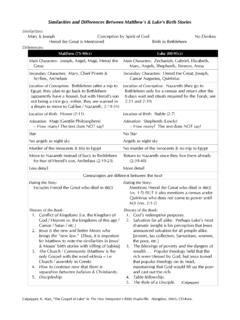Transcription of Similarities and differences between TQM, six sigma and lean
1 Similarities and differencesbetween TQM, six sigma and leanRoy Andersson, Henrik Eriksson and Ha kan TorstenssonSchool of Engineering, University College of Bora s, Bora s, SwedenAbstractPurpose During the last decades, different quality management concepts, including total qualitymanagement (TQM), six sigma and lean, have been applied by many different organisations. Althoughmuch important work has been documented regarding TQM, six sigma and lean, a number ofquestions remain concerning the applicability of these concepts in various organisations and , the purpose of this paper is to describe the Similarities and differences between the concepts,including an evaluation and criticism of each Within a case study, a literature review and face-to-faceinterviews in typical TQM, six sigma and lean organisations have been carried While TQM, six sigma and lean have many Similarities , especially concerning origin,methodologies, tools and effects, they differ in some areas, in particular concerning the main theory,approach and the main criticism.
2 The lean concept is slightly different from TQM and six , there is a lot to gain if organisations are able to combine these three concepts, as they arecomplementary. Six sigma and lean are excellent road-maps, which could be used one by one orcombined, together with the values in The paper provides guidance to organisations regarding the applicability andproperties of quality concepts. Organisations need to work continuously with customer-orientatedactivities in order to survive; irrespective of how these activities are labelled. The paper will also serveas a basis for further research in this area, focusing on practical experience of these management, Six sigma , Total quality management, Lean production,Quality improvementPaper typeResearch paperIntroductionWhile management is considered as relatively immature compared to other socialsciences, the field has been bombarded with fads see, for example, Carsonet al.
3 (1999). In summary, the different management theories presented over the years, ofwhich some could be argued to be management fads, have been criticised forhaving four major defects. These major defects of the management theory are thefollowing:(1) it is constitutionally incapable of self-criticism;(2) its terminology and industry-specific jargon rather confuse than inform;(3) it rarely rises above common sense; and(4) it is replete with fads and plagued with contradictions that would be intolerablein other scientific disciplines (Carsonet al., 1999).The current issue and full text archive of this journal is available authors would like to thank Peter Ha yha nen, Peter Manfredsson and Anders Na slid at theBusiness Unit of Transmission and Transportation Networks at Ericsson for their contributionof valuable ,3282 The TQM MagazineVol.
4 18 No. 3, 2006pp. 282-296qEmerald Group Publishing Limited0954-478 XDOI the last decades, quality management has been put forward by a number of itspromoters as a new management theory, see, for example, Foley (2004). However,the description of what quality management is differs. Quality management can bedescribed as a management revolution, a revolutionary philosophy of management,a new way of thinking about the management of organisations, a paradigm shift, acomprehensive way to improve total organisational performance, an alternative tomanagement by control or as a framework for competitive management (Foley, 2004).Despite the high aims of promoters of quality management, the failures oforganisations trying to implement a successful quality management programmehave been well documented, see Brownet al.
5 (1994), Eskildson (1994), Harari (1997),Caoet al.(2000) or Nwabueze (2001). These failures have led some authors to questionwhether some concepts in the area of quality management are fads, see, for example,van der Wieleet al.(2000).John Godfrey Saxe s famous fable The Blind Men and the Elephant in which sixblind men attempt, and ultimately fail, to describe an elephant could actually be a gooddescription of quality management. In this well written story, each blind man touchesonly a part of the elephant. They go on to describe what the elephant feels example: one blind man says the elephant feels like a wall another blind mandescribes it as the elephant feels like a snake . In much the same way as each blindman forms a vision of the whole by examining a part, promoters of qualitymanagement have written books and articles and presented seminars about differentconcepts, which either are about the parts or are visions of the whole drawn from theknowledge of one or a few parts, see Foley (2004).
6 Concepts that have been presentedand promoted are, for instance, total quality management (TQM), six sigma , leanmanufacturing, business process re-engineering, just-in-time (JIT), Kaizen andBusiness , the description and definition of these different quality managementconcepts differ. For example, TQM is sometimes defined:..as a continuously evolving management system consisting of values, methodologies andtools, the aim of which is to increase external and internal customer satisfaction with areduced amount of resources, see Hellsten and Klefsjo (2000).Six sigma , on the other hand, is defined:..as a business process that allows companies to drastically improve their bottom line bydesigning and monitoring everyday business activities in ways that minimise waste andresources while increasing customer satisfaction by some of its proponents, see Magnussonet al.
7 (2003).NIST (2000) defines lean:..as a systematic approach to identifying and eliminating waste through continuousimprovement, flowing the product at the pull of the customer in pursuit of the definitions of TQM, six sigma and lean differ, the aim of the differentconcepts seems to be similar; through improvements minimising waste and resourceswhile improving customer satisfaction and financial results. These concepts also havethe same origin, the quality evolution in Japan after the World War II, see Dahlgaardand Dahlgaard (2001).TQM, six sigmaand lean283 With parallels to the fable described above, one could argue that differentpromoters in the field of quality management (the six blind men), who eachdescribes different quality management concepts (the wall, snake, etc.)
8 , are trying todescribe a part or a vision about the whole; the area of quality management(the elephant). However, the parts or the visions about the whole differ, according tothe definitions contributed of TQM, six sigma and lean (which also was the case forthe six blind men). Furthermore, the way to achieve these objectives seems to differbetween the different concepts. On the other hand, and as shown above, there arealso many Similarities , for example, with respect to the overall aim and , one could also argue that the different promoters (the six blind men) insome areas are able to describe a similar vision of the whole (a similar picture of theelephant). Hence, and in summary, this paper sets out to describe if the vision ofthe different promoters of quality management concepts (TQM, six sigma and lean)is the same or if it considerable progress has been made in the field of quality managementin general and in TQM, six sigma and lean in particular, many important issues remainunexplored concerning the Similarities and differences between these concepts.
9 Hence,the purpose of this paper is to describe Similarities and differences between TQM, sixsigma and lean. In specific, Similarities and differences concerning areas such as themethodologies, tools, effects and criticism are illuminated in this paper. Furthermore,an overall description of each concept is contributed in this paper. Moreover, differentmanagement theories have been criticised for having four major defects, see , the intention with this paper is also to present criticism of each concept (point 1)and inform, rather than confuse the reader about the Similarities and differences ofeach concept (point 2), see Carsonet al.(1999).Quality management conceptsTotal quality management (TQM)Quality has been an important issue for organisations for many years.
10 The early focuson quality evolved from inspection to quality control and later to quality assurance,according to Dale (1999). During the 1990s, TQM evolved as a common term amongorganisations. Different definitions of TQM have been presented over the al.(1998) view TQM as:..a corporate culture characterised by increased customer satisfaction through continuousimprovement, in which all employees in the firm actively al.(1993), on the other hand, argue that:TQM is an evolving system of practices, tools, and training methods for managing companiesto provide customer satisfaction in a rapidly changing and Klefsjo (2000) support the view that TQM is an evolving system. Hellstenand Klefsjo (2000) define TQM:..as a continuously evolving management system consisting of values, methodologies andtools, the aim of which is to increase external and internal customer satisfaction with areduced amount of and tools.




